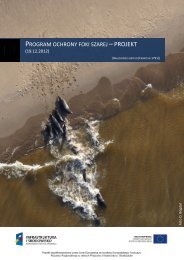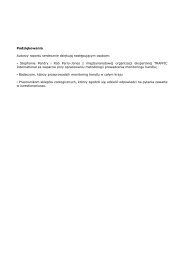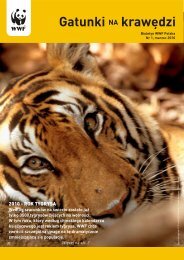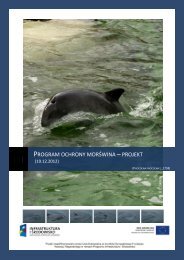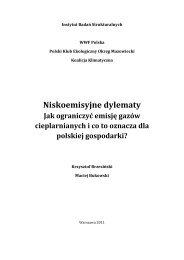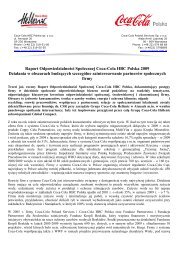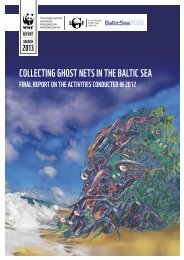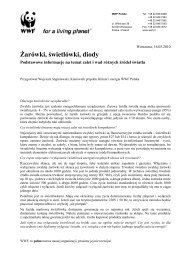Biodiversity, biocapacity and better choices
Biodiversity, biocapacity and better choices
Biodiversity, biocapacity and better choices
You also want an ePaper? Increase the reach of your titles
YUMPU automatically turns print PDFs into web optimized ePapers that Google loves.
Scramble for l<strong>and</strong>:Competing claims <strong>and</strong>commercial pressurel<strong>and</strong> <strong>and</strong> water resources they have held under customary tenure.Many cases show how the resource base of rural livelihoods is beingsqueezed through the loss of access to grassl<strong>and</strong>s, forests <strong>and</strong>marshl<strong>and</strong>s that are customarily held as common property. Thepoor are bearing disproportionate costs, but reaping few benefits,largely because of poor governance. The l<strong>and</strong> rush is also leadingto extensive conversion of natural ecosystems with accompanyinglosses of ecosystem services <strong>and</strong> biodiversity (Anseeuw et al., 2012).L<strong>and</strong> use decisions are invariably complex, involving manystakeholders with different priorities. Productive l<strong>and</strong> may besimultaneously in dem<strong>and</strong> by communities (e.g., homel<strong>and</strong>s <strong>and</strong>sacred sites), or for food production, forest products, biodiversityconservation, urban development or carbon storage. Renewableenergy dem<strong>and</strong>s add an extra dimension, through use of l<strong>and</strong> forbioenergy feedstock production. The situation is further complicatedby the interdependence between the production <strong>and</strong> consumptionof key resources such as food, fibre, energy <strong>and</strong> water. Agriculturerequires l<strong>and</strong>, water <strong>and</strong> energy; water extraction <strong>and</strong> distributionrequire energy; <strong>and</strong> energy production often requires water (WorldEconomic Forum, 2011). All require ecosystem services, <strong>and</strong> onel<strong>and</strong> use decision can affect the provision of many different services.Moreover, the poorest <strong>and</strong> most vulnerable people are most affectedby the consequences of poor l<strong>and</strong> use <strong>choices</strong>, while being the leastable to influence such decisions.The frequency <strong>and</strong> complexity of l<strong>and</strong> use competition isexpected to rise as human dem<strong>and</strong>s grow.Scramble for l<strong>and</strong>: Food <strong>and</strong> fuelThroughout the developing world, external investors are scramblingto secure access to agricultural l<strong>and</strong> for future food production.Since the mid-2000s, it is estimated that an area almost the size ofWestern Europe has been transferred in l<strong>and</strong> allocation deals. Thelatest rush for farml<strong>and</strong> was triggered by the food crisis of 2007-08, but long-term drivers include population growth; increasedconsumption by a global minority; <strong>and</strong> market dem<strong>and</strong>s for food,biofuels, raw materials <strong>and</strong> timber (Anseeuw et al., 2012).Recent research shows that deals reported as approved orunder negotiation worldwide amounted to a total of 203 millionhectares: 134 million hectares of this total are located in Africa;43 million hectares in Asia <strong>and</strong> 19 million hectares in Latin America.Of these, deals for 71 million hectares have so far been crossreferenced,confirming the unprecedented scale of the l<strong>and</strong> rushover the past decade (Anseeuw et al., 2012).The best agricultural l<strong>and</strong> is often targeted for thisacquisition. The rural poor are frequently being dispossessed ofthe poorest <strong>and</strong>most vulnerablepeople are mostaffected by theconsequences ofpoor l<strong>and</strong>-use<strong>choices</strong>An area almost thesize of WesternEurope has beentransferred in l<strong>and</strong>allocation dealssince mid-20005.2 millionhectares of l<strong>and</strong> inPapua New Guineahas been acquiredfor long-termleasesCase study: Papua New GuineaIn the last five years, 5.2 million hectares of l<strong>and</strong> in Papua NewGuinea has been acquired for long-term leases – termed SpecialAgricultural <strong>and</strong> Business Leases (SABLs). These now encompass15 per cent of the country’s l<strong>and</strong> area. Nearly all of these leases havebeen h<strong>and</strong>ed to foreign investors or multinational corporations –mostly for logging <strong>and</strong> oil palm plantations. Under existing SABLs,around 2 million hectares of forests are allowed to be legally cleared.In a number of cases, the leases appear to have been grantedwithout the free <strong>and</strong> prior consent of a majority of the traditionall<strong>and</strong>owners, which is a legal requirement in Papua New Guinea.In response to a growing domestic <strong>and</strong> international outcry, thegovernment declared a temporary moratorium on SABLs, butthis offers only a temporary respite to one of the most serious<strong>and</strong> immediate threats to the country’s forests <strong>and</strong> biodiversity(Laurance, 2012, in press).The sheer pace of change demonstrated by this exampleunderlies an urgent challenge: to stop dispossession <strong>and</strong> l<strong>and</strong>allocations that do not serve a genuine public interest; to legallyrecognize the rights of the rural poor; <strong>and</strong> to steer toward moreequitable models that give a key role to existing l<strong>and</strong> users(Anseeuw et al., 2012).The L<strong>and</strong> MatrixThe L<strong>and</strong> Matrix is an online public database of large-scale l<strong>and</strong>deals. It is facilitated by a partnership of organizations withan interest in promoting transparency <strong>and</strong> accountability indecisions over l<strong>and</strong> <strong>and</strong> investment through open data. The L<strong>and</strong>Matrix aims to provide a permanent observatory to which anyuser can contribute information. www.l<strong>and</strong>portal.info/l<strong>and</strong>matrixWWF Living Planet Report 2012 page 88 Chapter 2: Why we should care page 89



